 British Pre-dreadnoughts
British Pre-dreadnoughtsHMS London, Bulwark, Venerable, Queen, Prince of Wales
WW1 RN Battleships
HMS Dreadnought | Bellerophon class | St. Vincent class | HMS Neptune | Colossus class | Orion class | King George V | Iron Duke class | HMS Agincourt | HMS Erin | HMS Canada | Queen Elizabeth class | Revenge class | G3 classMajestic class | Centurion class | Canopus class | Formidable class | London class | Duncan class | King Edward VII class | Swiftsure class | Lord Nelson class
Invincible class | Indefatigable class | Lion class | HMS Tiger | Courageous class | Renown class | Admiral class | N3 class
The London class comprised five pre-dreadnought battleships. They were planned in mid-1890s and, built and commissioned in the early 1900s. The class was basically a repeat of the preceding Formidable class with incremental changes, in that case the armour layout. Artillery was the same as before and by contract, top speed was always 18 knots (33 km/h; 21 mph). For some authors, their similarity with the Formidable class made them a sub-class and the last two sometimes called the “Queen class” due to also some design differences. They came from the Portsmouth, Devonport, and Chatham Dockyards.
All five ships of the class served with the Mediterranean Fleet like most pre-dreadnought, a less contested sector. While peacetime was uneventful but some collisions, from 1907, they were transferring back to home waters and spread between the Home Fleet, Channel Fleet, and Atlantic Fleet. By 1912–1913 they were all in the 5th Battle Squadron, Home Fleet and escorted the British Expeditionary Force to France in 1914. They eventually returned to the Mediterranean for the 1915 Dardanelles Campaign, at Anzac Cove, but later withdrawn to bolster the Italian fleet’s Austro-Hungarian Navy blockade. They were all discarded in the early 1920s.
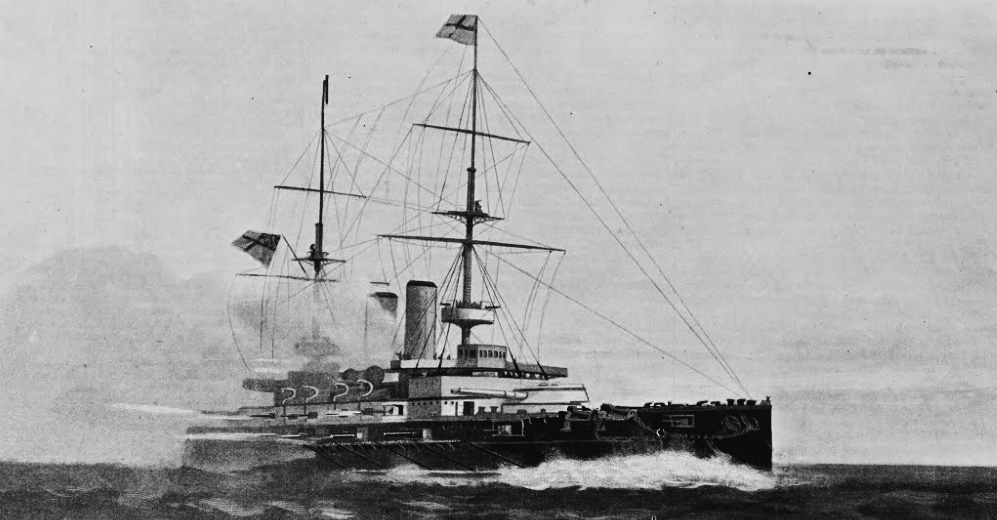
Design development
The London class found its origin in the 1898 construction programme. Three additional battleships to counter the Russian navy back then. They became the first of the London class. To gain time, they were very closely based on the preceding Formidable class, to start construction asap. The new design engineers worked on needed more time to be refined and ended as the later Duncan class, delayed to concentrate on the Londons. Londons and the Formidables were very close, but mostly differed by their armour: The former had a thinner deck armour, revised belt armour arrangement and bow protection, plus minor detail changes in the general scheme. In the end, this produced a heavier displacement.
Two more ships repeats of the London class were ultimately ordred, HMS Prince of Wales and Queen. They were identical except their open 12-pdr gun batteries relocated on the upper deck amidships, and a slightly lower displacement. In the end, they together formed a full group of eight battleships to the same standard, together with the Formidable class. Queen and Prince of Wales were laid down after the Duncan-class which were the successors of the Formidable/London classes. They were also completed afterwards. Some authors seems list them as a separate Queen class.
For the anecdote, HMS Prince of Wales was the last ships desifned under the direction of Naval Construction Director Sir William Henry White. She was also the last of the 29 battleships of the Majestic, Canopus, Formidable, London, and Duncan classes (1895-1904) derived from the early “template” that was the Majestic design, closing a long evolution path with gradual innovations. The following King Edward class (1903) was a brand new breed, a transitional “semi-dreadnought class”, confirmed later by the Lord Nelson class of 1906. See the whole lineage for clarity.
Design
Hull & general characteristics
A very close design to the other series, the London class had a 400 feet long hull between perpendiculars, up to 431 feet 9 inches (131.60 m) overall. They were 75 ft (23 m) in width, with a draught of 26 ft (7.9 m) deep. Displacement 14,500 long tons standard, 15,700 long tons fully loaded. HMS Queen and Prince of Wales were lighter at 14,150 long tons/15,400 long tons. General appearance was respected as standard, a ram, stern galley, central superstrcuture and two bridges for and aft, two pole masts, two axial funnels, fighting tops with searchlight, and four additional searchlights on the forward and aft bridges.
The crew was 714 strong, but varied depending on their various transformations over time. In reality complament varied between 724 and 768, up to 803 as flagship with a command staff, down to 361 or less as depot ship. They were equipped also with the Type 1 wireless telegraphy set, later upgraded to Type 2 sets in 1909–1910. The small boats carried included steam and sail pinnaces and launches, two cutters, galleys and whalers as well as three gigs, dinghies, and rafts. The largest could be combined with the field gun and machine guns for landing parties.
Armour
Protection against ASW threats was of course limited, and their hulls were divided with longitudinal bulkheads usrd for counter-flooding, but with limited equipment. There was no double hull also. Below are listed figures for each armored part of the ships and respective armour thicknesses. These ships (and the Queen class) mixed Krupp armour, Harvey armour, nickel steel and mild steel (for unarmoured superstructure and internal compartimentation). The arrangement was incrementally improved and already integrated researches made for the Duncans with with thinner figures than the latter. However contrary to previous practice, there was no transverse bulkhead on the forward citadel, but one aft only. It was omitted to save weight, used instead to extend the belt armour for the whole lenght, with reduced thicknesses at both ends.
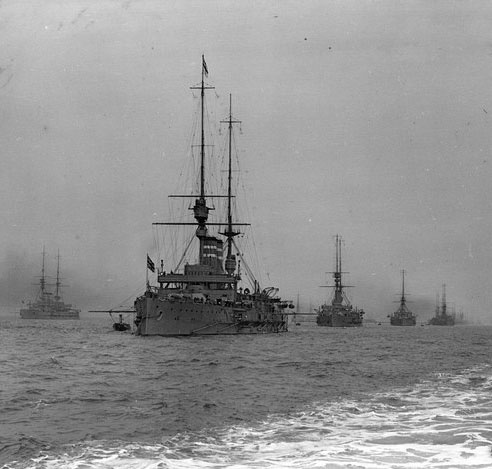
Forward of the barbette, the belt was in four successive thicknesses from 7 to 2-in. Another change was the use of turrets which were not curved by with flat-face, as a result of the adoption of Krupp armour, easier to manufacture than Harvey steel. The forward conning tower was the best protected part of the ship, less so for the aft CT, and armored decks were two-layared, notably for stability reasons, with a main waterline deck 2.5 times thickerthan the casemate deck. The lack of a forward bulkhead, leaving an uprotected citadel when facing forward was a calculated risk. At that time, broadside formations were still found ideal so that sacrifice was deemed possible.
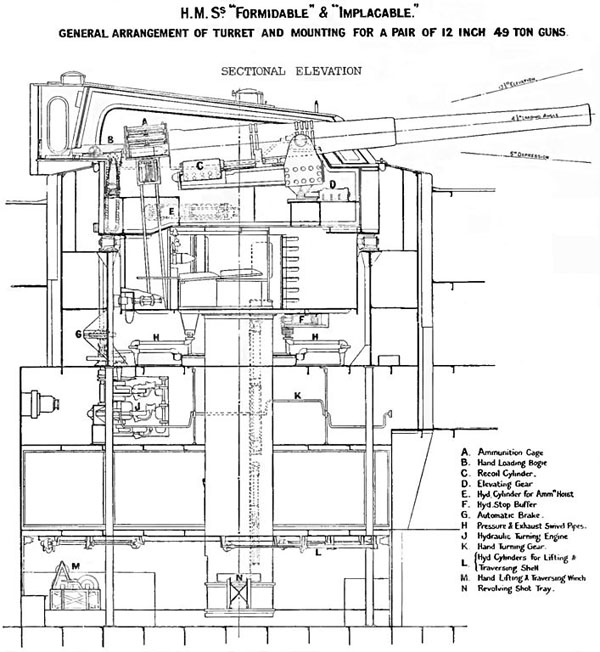
- Main armoured belt: 9 inches (229 mm)
- Aft transverse bulkhead 9-12 in (229-305 mm)
- Forward belt 7,5,3,2 in (178,127,76,51mm)
- Main turrets side 8 in (203 mm)
- Main turrets front 10 in (254 mm)
- Main turret roofs 2-3 in (51-76 mm)
- Barbettes 12 in (305 mm) above Armor deck
- Casemate battery 6 in (150 mm) Krupp
- Casemate side/back 2 in (51 mm) Krupp
- Casemates ammunition hoists 2 in
- FWD Conning Tower 10-14 in (254-356 mm)
- Aft conning tower 3 in (76 mm)
- Upper armored deck 1 in (25 mm)
- Main armored deck 2.5 in (64 mm)
Powerplant
The London-class had a repeat of the Formidable powerplant: Essentually two 3-cylinder, triple-expansion engines driving two inward-turning screw propellers. They were fed by twenty Belleville boilers. The Queen sub-class however had thirteen more modern Babcock & Wilcox boilers. These boilers were isolated in three boiler rooms, trunked into two funnels. Return of experience with Belleville boilers on the Formidable-class was still not there when decision was made for the London class, but this altered the next Queen class. Decision was made as the Queen and Prince of Wales were under construction. This required many alterations in the boiler rooms of HMS Queen, but Prince of Wales was too advanced for this and retained her Belleville. Only HMS Queen, of the whole serie of eight battleship, had the new boilers.
The London-class ships like their predecessors were contracted for 18 knots (33 km/h; 21 mph), based on 15,000 indicated horsepower (11,000 kW). On sea trials, they all exceeded this design speed, using slight force heating and reaching 18.04-18.4 knots (33.41 to 34.08 km/h; 20.76 to 21.17 mph) and up to 15,660 ihp (11,678 kW). For their range, normal load was 900 long tons (910 t) of coal, which could be extened in wartime or long travels to 2,000 long tons by filling many void compartments, notably underwater. Cruising radius therefore reached 5,550 nautical miles (10,280 km; 6,390 mi) at 10 knots. HMS Prince of Wales’s boilers were less efficient and she was estimated at 5,400 nmi.
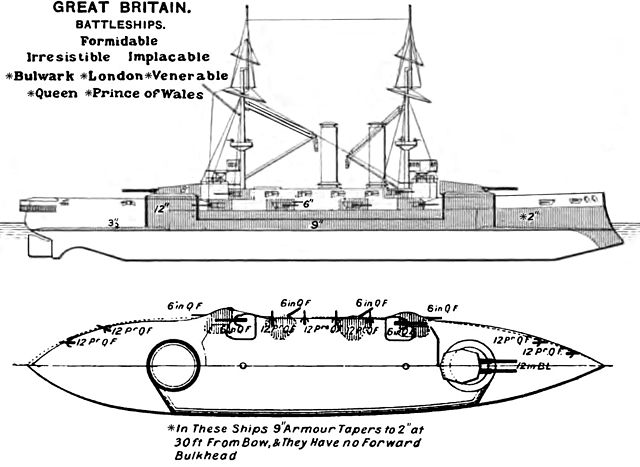
Formidable class line drawing (brasseys), the London class was very close.
Armament
The recipe was intangible: Two pairs of main guns in turrets for and aft, twelve 6-in guns in casemated guns, six per side on two levels, a light battery for anti-torpedo boat warfare with 3-in and 3-pdrs, and the usual submerged fixed torpedo tubes.
Main guns:
Four 12-inch (305 mm) 40-calibre, Mark IX in twin turrets, fore and aft. Used BVI mountings allowing loading in any elevation or traverse angle, with the exception of HMS Venerable: She received BVII mountings. 80 shells were provided fr each of these guns, so 320 total, HE and AP types. Elevation range from -5° to 13.5°, and max 4.5° to be loaded. However Venerable’q BVII mounts allowed any angle. Muzzle velocity was 2,562-2,573 fps(781 to 784 m/s) deping of the type. The AP type was capable of penetrating 12 in of Krupp armour at 4,800 yards (4,400 m). Max range was 15,300 yards (14,000 m), only useful in shore bombardment.
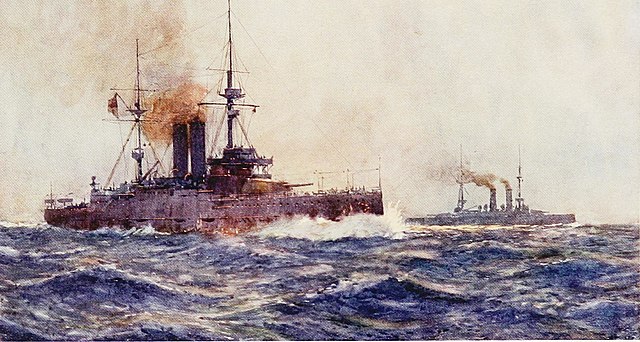
Secondary battery
The twelve casemated individual 6-inch (152 mm) 45-calibre Mark VII guns were placed on the main battery level four of them per side, under deck level, with recesses fore and aft. In case of heavy weather, their usefulness was limited. So they also had the four remainder placed at the upper level, on each corner of the main superstructure. They all received 200 shells per gun, so a total of 2,400 generally of the HE type to deal with cruisers and lighter ships or damage battleship’s superstructures. They had a muzzle velocity of 2,536 ft/s (773 m/s) and were proven able to defeat 6 in Krupp armour at 2,500 yards (2,300 m). Elevation reached 14° allowed a maximal 12,000 yards (11,000 m) range.
Light Battery
For close-quarter defence, London, Venerable and Bulwark had sixteen 12-pdr guns, all in pivot mounts, and all provided with 300 rounds. Three per side were in recesses in the upper hull level, the rest placed along side the upper casemate deck behind walls (8). Four more were placed over the main turret’s roofs. The following HMS Queen and Prince of Wales were given fourteen guns, not sixteen. On the Duncan it was ten (none of the turret’s tops and two less in the less). The last line of defense was procured by six 3-pounder guns located in the armored tops. But the ships also carried two 12-pounder field guns and two machine guns intended for the steam boats used in a landing party. The four 18-inch (457 mm) torpedo tubes were submerged and broadside, abreast each barbette fore and aft.
- 4x 12 in (305mm)/40 Mk IX
- 12x 6-in (152 mm)/45 Mk VII
- 16x 3-in (12 pdr/76 mm)
- 6x 3 pdr (47 mm)
- 4x 18-in sub TTs (457 mm)
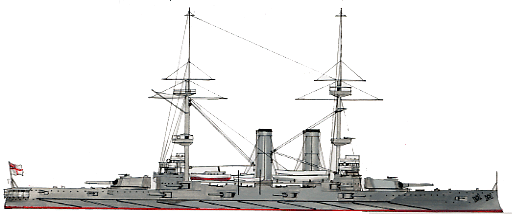
Author’s illustration of HMS London
⚙ Specifications |
|
| Displacement | 14,500 long tons, 15,700 long tons FL |
| Dimensions | 131.6 m oa x 22.9m x 7.9m (431.9 x 75 x 26 feets) |
| Propulsion | 4x 3-cyl VTE, 20 Belleville boilers, 15,000 ihp (11,900 kW) |
| Speed | 18 knots (33 km/h; 20.7 mph) |
| Range | 5,500 nmi (10,300 km; 6,400 mi) at 10 knots |
| Armament | 2×2 12in, 12x 6 in, 16x 3in, 6x 3pdr |
| Armor | Belt: 9 in, Bulkhead 9–12 in, Barbettes 12 in, Turrets 10 in, Casemates 6 in, CT 14 in, deck 2.5 in |
| Crew | 714 |
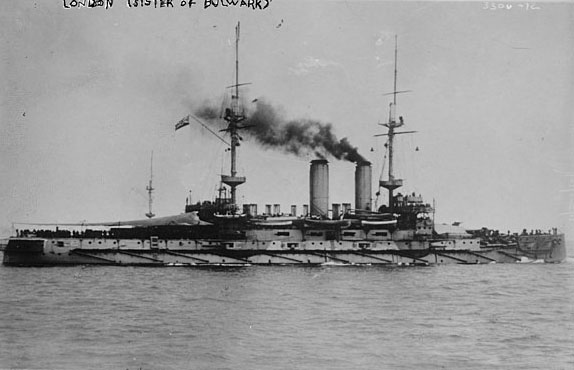
Read More/Src
Gardiner, Robert, ed. (1979). Conway’s All the World’s Fighting Ships: 1860–1905
Burt, R. A. (2013) 1988. British Battleships 1889–1904. Seaforth Publishing
Corbett, Julian Stafford (1920). Naval Operations: To The Battle of the Falklands, December 1914.
Also from The Battle of the Falklands to the Entry of Italy Into the War in May 1915. and The Dardanelles Campaign.
Friedman, Norman (2011). Naval Weapons of World War One: Guns, Torpedoes, Mines and ASW Weapons of All Nations
Gibbons, Tony (1983). The Complete Encyclopedia of Battleships and Battlecruisers, Technical Directory
Halpern, Paul G. (1995). A Naval History of World War I.
Pears, Randolph (1979). British Battleships, 1892–1957: The Great Days of the Fleets.
Willmott, H. P. (2009). The Last Century of Sea Power (Volume 1, From Port Arthur to Chanak, 1894–1922).
Dittmar, F. J. & Colledge, J. J. (1972). British Warships 1914–1919. London: Ian Allan.
Parkes, Oscar (1990) [1957]. British Battleships. Annapolis: Naval Institute Press.
Dittmar, F. J. & Colledge, J. J. (1972). British Warships 1914–1919. London
Parkes, Oscar (1990). British Battleships. Annapolis: Naval Institute Press

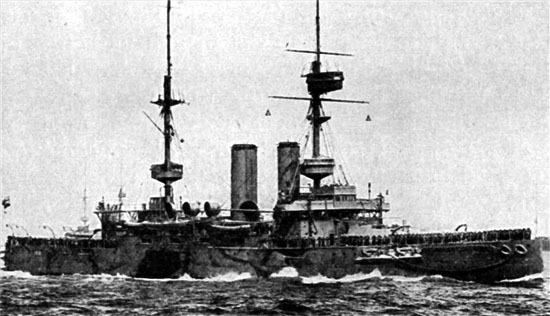
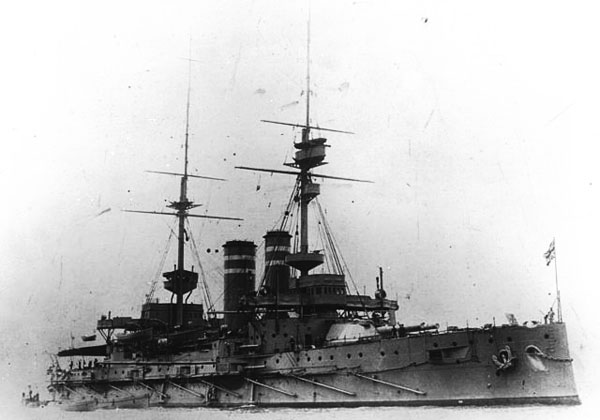
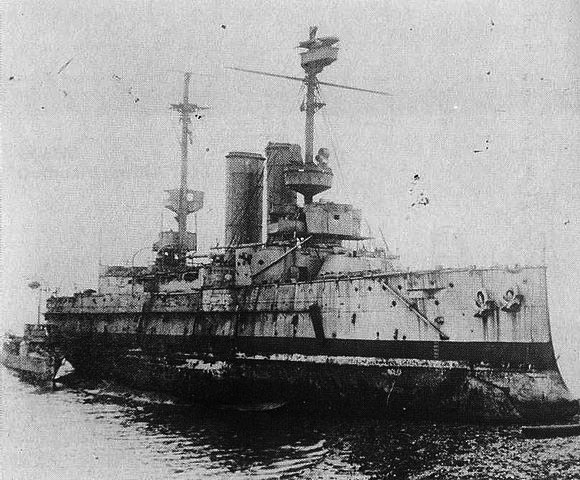
PoW pending scrapping 1920
On dreadnoughtproject.org
On battleships-cruisers.co.uk
On navypedia
On worldnavalships.com
On historyofwar.org
London class on wpd
The models corner
HMS Queen, Prince of Wales – Kombrig 1/700
The London & Queen classes in action
HMS London
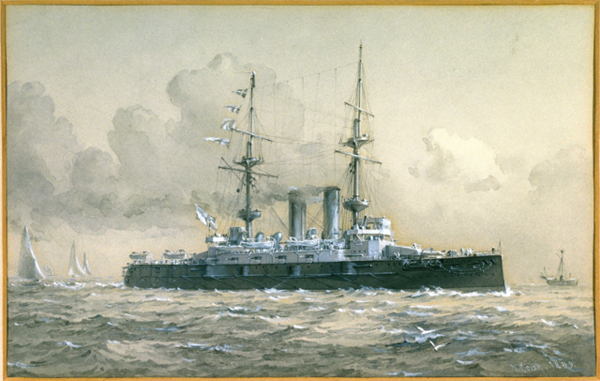
London painting 1890s
Prewar
HMS London built at Portsmouth Dockyard between 8 December 1898, her launch on 21 September 1899 and completetion in June 1902. Commissioned on 7 June 1902 after her sea trials, she was sent to the Mediterranean, under command of Captain James Goodrich. Before this, she served as flagship for King Edward VII’s Coronation Review at Spithead in June 1902, but as the latter fell ill it was pushed back for August 1902 and London sailed south. She arrived in Malta on 14 July and in September cruised the Aegean and took part in combined manoeuvres off Nauplia, followed by a short Malta in 1902–1903 and another in 1906. Her 3-pounder guns were removed each time. In March 1907, she joined Nore Division (Home Fleet) and Channel Fleet from 2 June 1908 as Flagship for the Rear Admiral. After another refit at Chatham in 1908 seeing notably a flying bridge installed aft, she was later recomm. on 19 April 1909 for another refit, with the removal of her flying bridge. She sailed on 8 February 1910 to be used as Second Flagship Atlantic Fleet. On 1 May 1912 her unit was now part of the Second Home Fleet, Nore. Her crew was reduced and she was sent to the 3rd Battle Squadron.
She collided with the merchant steamer SS Don Benite on 11 May 1912, but damage was light. She joined the 5th Battle Squadron and started tests of aircraft taking of from an improvized platform May 1912-1913. A ramp was installed on the forecastle, formerly tested on HMS Hibernia. Commander Charles Rumney Samson formerly conducted there the world’s first takeoff from a moving ship back in May from Hibernia (Short S.27) and also from HMS London on 4 July 1912. Newt year saw her anti-torpedo nets removed.
Wartime operations
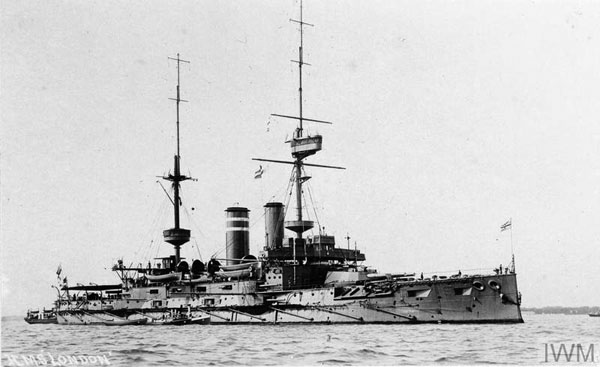
London painting 1890s
By August 1914 she was part of the 5th Battle Squadron, Channel Fleet (Portland). She escorted the British Expeditionary Force across the English Channel and right away, experimental paint schemes were tried on her hull, quickly abandoned as battleship grey was adopted for all ships in the navy. She was transferred to Sheerness on 14 November 1914, in prevision of a possible German invasion, seeing first hand the terrifying explosion of her sister-ship HMS Bulwark, her crew joining the rescue. The enquiry later took place onboard London. They were back to Portland on 30 December 1914. By January 1915 however an operation was planned in the estern Mediterranean, and the 5th Battle Squadron was mobilized.
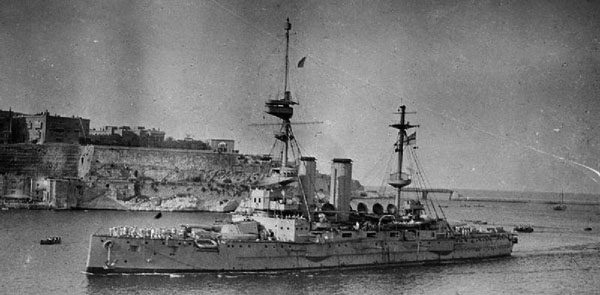
London in Malta, 1915
Dardanelles campaign & Otranto
In late January London, Queen, Prince of Wales and Implacable escorted by the light cruisers Topaze and Diamond were assembled at Portland, but only prepared to depart in March 1915, scheduled to attack on 18 March under overall command of Admiral Sackville Carden. The latter requested HMS Implacable and HMS Queen to be transferred as a reserve, but after loosing two battleships, the Admiralty disbanded the 5th Squadron and London, Prince of Wales were to join the fleet, with new 3-pounder AA guns installed on their quarterdecks and anti-torpedo nets refitted.
London was off Lemnos by 23 March and prepared for the landings at Cape Helles and Anzac Cove as part of the 2nd Squadron (Rear Admiral Cecil Thursby), and she supported the landings at Gaba Tepe and Anzac Cove on 25 April 1915. With Queen and Prince of Wales she covered the 3rd Australian Brigade, London herself given the left beach sector. Thery hammered trenches and supposed Ottoman positions as well as suppressed Ottoman artillery. She was later transferred to the 2nd Detached Squadron sent at Otranto, at the mouth of the Adriatic Sea. Later she sailed to Gibraltar in October 1915 for a refit and returned.
Home waters
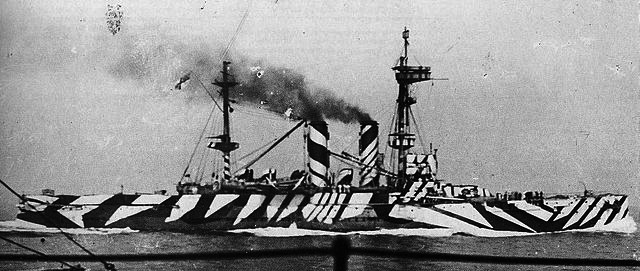
HMS London in dazzle camo as a minelayer, 1918
In October 1916 she was sent back to the UK to be paid off at Devonport, freeing crews for much needed ASW escorts. A refit took place evertheless in 1916–1917, her main deck 6-in guns, upper deck 12-pounder removed, and four lower 6-in moved on the upper deck battery. Nothing much happened until February 1918 until the dmiralty decided she would be useful as a minelayer, and she was moved to Rosyth for conversion: Her 12-in guns were removed, anti-torpedo nets, aft turret remived and replaced by a 6-in gun, minelaying equipment installed on her quarterdeck (240 mines rails), canvas screen for concealment and the finishing touch, an experimental dazzle camouflage. She was ready in April 1918, recomm. at Rosyth in May 1918 and she laid 2,640 mines for the Northern Mine Barrage as the war ended. She was reduced to reserve in January 1919 at Devonport, then depot ship, 3rd Fleet. Disposal list in January 1920, sale list on 31 March, sold to Stanlee Shipbreaking on 4 June, then resold Slough Trading Company, and then a German firm, towed to Germany and scrapped by April 1922.
HMS Bulwark
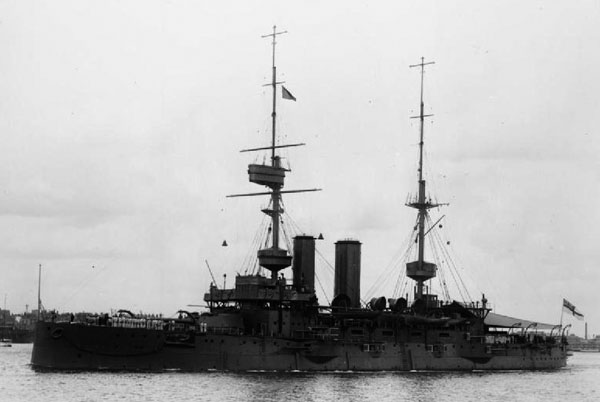
HMS Bulwark 1899
Prewar
Despite her name oozing strenght, she was lost in one of the most dramatic accidental explosion in British naval history, making her wartime career fairly short. In peacetime, launched at HM Dockyard in October 1899 she was commissioned by Captain Frederick Hamilton on 18 March 1902 and sent to the Mediterranean Fleet (Admiral Sir Compton Domvile, Commander-in-Chief) made her his flagship. Fro Gibraltar sh sailed to Malta where she was based. She headed the squadron visiting the Aegean Sea for combined manoeuvres with he sister-ships and visiting Lemnos and Nauplia but later suffered from a collision with HMS Formidable while under tow.
She took part in combined manoeuvers with the Channel Fleet off Greece and Italy. She visited Cagliari in Sardinia. From 18 April 1903 she hosted King Edward VII for a fleet review. She was also visited in Portugal later by King Carlos I. She also hosted in Malta Kaiser Wilhelm II in April 1904, even assuming temporary command as honorary Admiral. The Mediterranean Fleet was recalled to Malta in October after the Dogger Bank Incident with Russian Baltic Fleet heading for the pacific (Risso-Japanese war) as they mistook trawlers for Japanese TBs. The War preparations were cooled down on 2 November after the Russians showing good will in the affair. On 10 December, HMMS Bulwark was paid off in UK, refitted, recommissioned on 3 January 1905 (Edward Philpotts), returning two day after to Malta.
There, she was again flagship, admiral Domville. In June she visited Genoa and was back to Malta with a new fleet commander, Admiral Lord Charles Beresford. She underwent a new refit at Malta from October 1905 to February 1906. She notably received new spotting tops with 4-ft 6 in (1.37 m) Barr & Stroud coincidence rangefinders. She sailed to Lagos in Portugal and met with the Channel and Atlantic Fleets for combined manoeuvres , then the annual manoeuvres from 24 June off Portugal. On 19 January 1907, she sailed to Portsmouth, paid off and recommissioned (Captain Bertram Chambers) as flagship, Rear-Admiral Frank Finnis, Nore Division (Home Fleet). She visited Trondheim, Invergordon and aprticipated in the Cowes fleet review. She ran aground twice near Lemon Light, North Sea, while trying to avoid Dutch fishing ships, slightly damaged, repaired in drydock at Chatham in October. She sailed again from 9 March 1908, making torpedo and gunnery training, eventually recommissioned with a small crew from HMS Majestic, transferred to the Channel Fleet, Plymouth Sound. Her worn-out gun barrels were replaced later at Dovonport until 3 March 1909. Her Channel Fleet unit was versed to the 2nd Division, Home Fleet. She took part in another fleet review at Spithead in June.
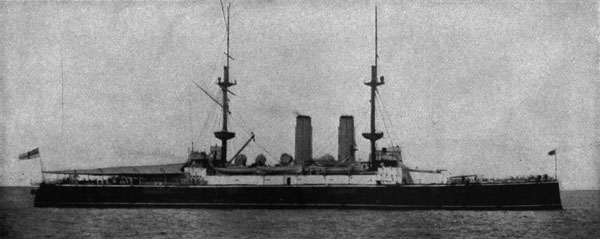
She was refitted at Devonport until December, paid off in February 1910, recommissioned into the reserve (Devonport). Under Captain George Hope in March she participated in the annual manoeuvres. She was later recomm. as aprivate ship for Vice-Admiral Prince Louis of Battenberg, present during the Coronation Fleet Review of King George V. She underwent another refit betwee 1 September 1911 and 1 May 1912, seeing notably her 3-pounders removed or repositioned on the bridge. The battleship started to show her bad luck when during her sea trials she grounded twice on Barrow Deep. After repairs she joined the 5th Battle Squadron, Second Fleet, and briefly as flagship in August-September. She was refitted at Portsmouth until June 1913 and participated in annual fleet manoeuvres. She was visited by King Christian X of Denmark in May 1914. Refitted at Chatham until 9 July she was prepared for test mobilisation (July Crisis), finally ordered on 15 July.
Wartime service

With the 5th BS, HMS Bulwark was in Portland, Channel Fleet. She escorted the British Expeditionary Force but remained afterwards in Portsmouth and Portland. She hosted the court martial of Rear-Admiral Sir Ernest Charles Thomas Troubridge (failed pursuit of SMS Goeben and SMS Breslau). She was transferred to Sheerness, like London (see above), but at this occasion, at about 07:53 on 26 November, she suffered a dramatic explosion while moored at Number 17 buoy, Kethole Reach west of Sheerness, River Medway estuary. All officers were killed and all but 12 ratings in the crew, a total of 741 men. This even included members of the band of the gunnery school HMS Excellent playing aboard at that time.
The shattering effect of the explosion was such that only 30 bodies were recovered afterwards. This was the second most catastrophic accidental explosion with the dreadnought Vanguard later in 1917. There was an enquiry from 28 November, which ruled out external attacks (torpedo/mine) based on eyewitnesses accounts. A flash was spotted near the aft turret and possible explosions against the outer hull. The board concluded that cordite charges were stowed against one of the boiler-room bulkheads which grew hot as the boilers were fired up, igniting the cordite. Nearby shells soon exploded in turn and this spread into the aft 12-inch magazine exploding in turn in a monumental reaction chain.

HMS Venerable
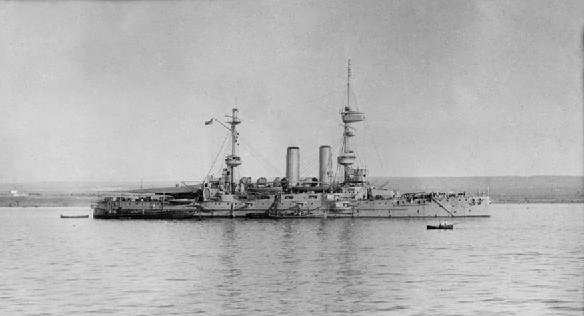
HMS Venerable Malta 1915
HMS Venerable (Chatham Dockyard) was commissioned on 12 November 1902 (Captain George Edwin Patey). She became Second Flagship, Rear Admiral of the Mediterranean Fleet, leaving Chatham on 20 November. In 1903, she tested a new fire control system. She later ran aground off Algiers but hull damaged was light, swiftly repaired at Malta in 1906–1907. In August that year she was replaced by HMS Prince of Wales and left on 6 January 1908, paid off at Chatham, recommissioned on 7 January 1908 for the Channel Fleet. New refit in February 1909, 3-pounder guns removed, rangefinder installed on her foremast, recommissioned on 19 October 1909, Atlantic Fleet. May 1912: Second Home Fleet, Nore, 5th Battle Squadron, with reduced crew. 1913 anti-torpedo nets removed, 2 searchlights added on her forward bridge.
When WWI broke her unit the 5th Battle Squadron joined the Channel Fleet from Portland. On 25 August 1914 she covered the Portsmouth Marine Battalion in Ostend and in October took part in Dover Patrol bombardment missions. She shelled German piositions between Westende and Lombardsijde and the Battle of the Yser. She became flagship of the Dover Patrol (Rear Admiral Sir Horace Hood). Her patrol was threatened later by German field guns moved up close to shor and later a spotted German U-boat. Venerable operated later with the gunboat HMS Bustard and three monitors and ran aground on an uncharted sandbank, later freed herself. Venerable was recalled as the situation changed. On 3 November, she joined the East Coast Patrols (and was there during Yarmouth’s raid). Her Battle Squadron was moved to Sheerness and back to Portland in December 1914. She shelled German positions near Westende in March 1915 (Battle of Neuve Chapelle).
In May, she was ordered to the Dardanelles in replacement to HMS Queen Elizabeth, sailing with HMS Exmouth. In August she shelled Ottoman positions at Suvla Bay. In October she retired at Gibraltar for a refit. Back in December 1915, she was sent to the Otranto fleet, stationed here until December 1916. Back to Portsmouth she was laid up and in February-March 1918 refitted as a depot ship, in Portland for minelaying trawlers. She brofly took part in the Northern Patrol until August 1918, Southern Patrol September-December and paid off at Portland, disposal list in May 1919, sold to Stanlee Shipbreaking Co. in June 1920, Slough Trading Co. 1922, and in Germany in 1922, towed there to be BU.
HMS Queen
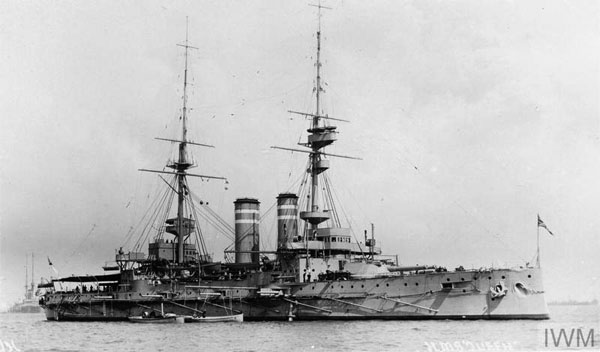
HMS Queen IWM
HMS Queen was built at Devonport, launched and named by Queen Alexandra on 8 March 1902, in the presence of King Edward VII, completed in March 1904 and commissioned on 7 April 1904 for the Mediterranean Fleet. She stayed at Malta in 1906–1907 as flagship and fleet flagship from 20 March 1907 for the Vice Admiral. By December 1908 she was sent with the Atlantic Fleet and collided with the Greek merchant steamer SS Dafni off Dover (1 February 1909) taking only light damage. After her Devonport refit in 1910–1911 she was from 15 May 1912 transferred to the Second Home Fleet. In April 1914, she was 2nd Flagship (Rear Admiral), 5th Battle Squadron (Second Fleet) like her sisters, used as a gunnery training ship at Portsmouth.
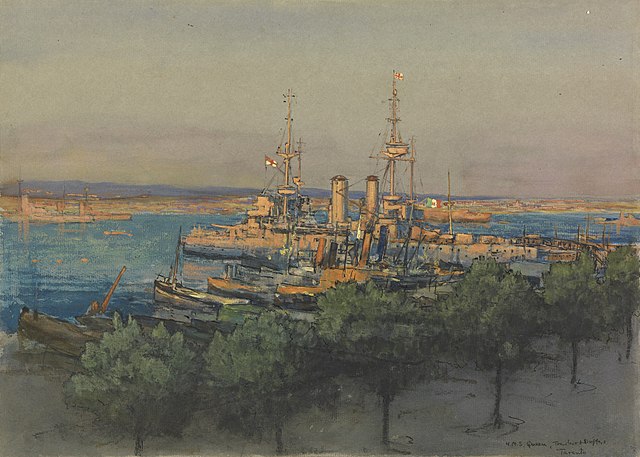
HMS Queen with Trawlers and drifters at Taranto
By August 1914 her Battle Squadron was tasked to the Channel Fleet from Portland. With HMS Implacable she joined the Dover Patrol by late October, shelling German positions along the Belgium coast until this was n longer possible. She also brought a vital support to French positions east of Dunkirk. She was affected for a short time to the Harwich Force in high alert of a German cruiser counterattack. Her Battle Squadron was transferred to Sheerness and was back to Portland in December. She was prepared in March to sail for the Dardanelles requested by Admiral Sackville Carden, her and HMS Implacable. She arrived in Lemnos on 23 March 1915 and joined the 2nd Squadron, flagship, Rear Admiral Cecil Thursby. She was mobilized for support missions on Cape Helles, covering the ANZAC landings at Gaba Tepe on 25 April 1915, in particular the 3rd Australian Brigade, right side of the beach.
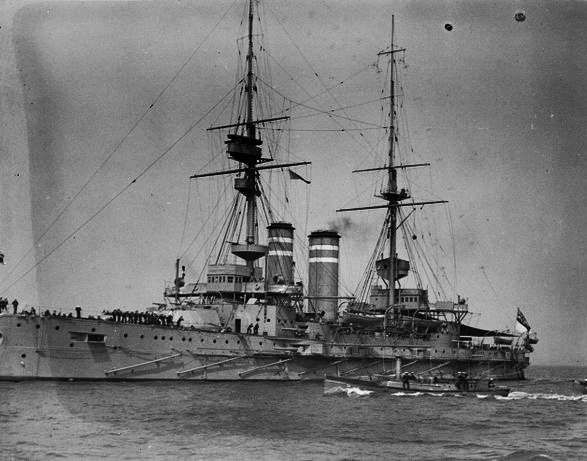
HMS Queen Spithead 1902
With Implacable, London, and Prince of Wales (2nd Detached Squadron) she was sent to the Italian Navy blockading the Otranto strait, arriving on 27 May 1915. By December 1916, until February 1917, she was refitted as depot ship for Otranto Barrage personnel, her crew reduced and the rest sent back home. This was a small care-and-maintenance crew while she was partially disarmed. Most of her 6-inch guns had has all been removed by April 1917 followed in October 1917 by her main guns, used by the Italian Army on the Isonzo front. HMS Queen was nevertheless the flagship and naval HQ of British Naval Forces in Taranto, until February 1918. She left for home in April 1919, and was placed in reserve at Chatham in May. Removed from the lists, she joined Pembroke as accommodation ship. She was sold for scrap on 4 September 1920, BU in Preston on 5 August 1921.
HMS Prince of Wales
img src=”photos/HMS_Prince_of_Wales_1902_Malta_1915.jpg”>
PoW in Malta, 1915
HMS Prince of Wales was launched at Chatham Dockyard in a ceremony attended by the Royalty, notably the Princess of Wales (later Queen Mary) on 25 March 1902, and of course the Prince of Wales (later King George V). Completed in March 1904 in Chatham she was commissioned on 18 May, Mediterranean Fleet. There, she collided with SS Enidwen off Oran (French North Africa) on 29 July 1905. Her main deck plating was damaged by an anchor. On 16 April 1906, this was more serious: She suffered from an engine-room explosion (3 killed, 4 injured). On 28 May, she was back to Portsmouth and in refit June-November. On 8 September 1905 she returned to the Mediterranean Fleet as flagship, second-in-command by August 1907, followed by a refit in Malta in 1908.
HMS Prince of Wales was then transferred to the Atlantic Fleet, as flagship in February 1909. A rather unlucky ship like Bulwark, she was damaged by an explosion in one of her stokeholds, on 2 July 1909. By December the newt year, she hosted Rear-Admiral(then) John Jellicoe as flagship. She was refitted in Gibraltar in February–May 1911 and back in the Home Fleet on 13 May 1912, flagship of the 3rd Battle Squadron, First Fleet, private ship in May, and flagship, second-in-command, Second Fleet in Portsmouth (5th Battle Squadron). In June 1913, she was rammed by HMS C32 during exercises (light damage). In May 1914, she was flagship of the 5th Battle Squadron.

Prince of Wales in 1912, IWM
Her service with the 5th Battle Squadron is about the same as her sister ships (see above): Channel Fleet (November) Portland, British Expeditionary Force escort, Channel patrols, Portsmouth Marine Battalion escort to Ostend, Sheerness ad back to Portland. In March she was schduled to depart for the Dardanelles. She covered the landing of the 3rd Brigade at Gaba Tepe and Anzac Cove in April. Then, she was affected to the Taranto blockade. On 22 May 1915, with Implacable, London, and Queen she formed the 2nd Detached Squadron, as flagship from March until June 1916. Refit to Gibraltar and back, and in February 1917, she stopped on her way home to Gibraltar until mid-March 1917. Placed in reserve, she became an accommodation ship, then stricken on 10 November 1919, sold on 12 April 1920, and BU in Milford Haven (Wales) in June 1920.


 Latest Facebook Entry -
Latest Facebook Entry -  X(Tweeter) Naval Encyclopedia's deck archive
X(Tweeter) Naval Encyclopedia's deck archive Instagram (@navalencyc)
Instagram (@navalencyc)





 French Navy
French Navy Royal Navy
Royal Navy Russian Navy
Russian Navy Armada Espanola
Armada Espanola Austrian Navy
Austrian Navy K.u.K. Kriegsmarine
K.u.K. Kriegsmarine Dansk Marine
Dansk Marine Nautiko Hellenon
Nautiko Hellenon Koninklije Marine 1870
Koninklije Marine 1870 Marinha do Brasil
Marinha do Brasil Osmanlı Donanması
Osmanlı Donanması Marina Do Peru
Marina Do Peru Marinha do Portugal
Marinha do Portugal Regia Marina 1870
Regia Marina 1870 Nihhon Kaigun 1870
Nihhon Kaigun 1870 Preußische Marine 1870
Preußische Marine 1870 Russkiy Flot 1870
Russkiy Flot 1870 Svenska marinen
Svenska marinen Søværnet
Søværnet Union Navy
Union Navy Confederate Navy
Confederate Navy Armada de Argentina
Armada de Argentina Imperial Chinese Navy
Imperial Chinese Navy Marinha do Portugal
Marinha do Portugal Mexico
Mexico Kaiserliche Marine
Kaiserliche Marine 1898 US Navy
1898 US Navy Sovietskiy Flot
Sovietskiy Flot Royal Canadian Navy
Royal Canadian Navy Royal Australian Navy
Royal Australian Navy RNZN Fleet
RNZN Fleet Chinese Navy 1937
Chinese Navy 1937 Kriegsmarine
Kriegsmarine Chilean Navy
Chilean Navy Danish Navy
Danish Navy Finnish Navy
Finnish Navy Hellenic Navy
Hellenic Navy Polish Navy
Polish Navy Romanian Navy
Romanian Navy Turkish Navy
Turkish Navy Royal Yugoslav Navy
Royal Yugoslav Navy Royal Thai Navy
Royal Thai Navy Minor Navies
Minor Navies Albania
Albania Austria
Austria Belgium
Belgium Columbia
Columbia Costa Rica
Costa Rica Cuba
Cuba Czechoslovakia
Czechoslovakia Dominican Republic
Dominican Republic Haiti
Haiti Hungary
Hungary Honduras
Honduras Estonia
Estonia Iceland
Iceland Eire
Eire Equador
Equador Iran
Iran Iraq
Iraq Latvia
Latvia Liberia
Liberia Lithuania
Lithuania Mandchukuo
Mandchukuo Morocco
Morocco Nicaragua
Nicaragua Persia
Persia San Salvador
San Salvador Sarawak
Sarawak Uruguay
Uruguay Venezuela
Venezuela Zanzibar
Zanzibar Warsaw Pact Navies
Warsaw Pact Navies Bulgaria
Bulgaria Hungary
Hungary

 Bundesmarine
Bundesmarine Dutch Navy
Dutch Navy Hellenic Navy
Hellenic Navy Marina Militare
Marina Militare Yugoslav Navy
Yugoslav Navy Chinese Navy
Chinese Navy Indian Navy
Indian Navy Indonesian Navy
Indonesian Navy JMSDF
JMSDF North Korean Navy
North Korean Navy Pakistani Navy
Pakistani Navy Philippines Navy
Philippines Navy ROKN
ROKN Rep. of Singapore Navy
Rep. of Singapore Navy Taiwanese Navy
Taiwanese Navy IDF Navy
IDF Navy Saudi Navy
Saudi Navy Royal New Zealand Navy
Royal New Zealand Navy Egyptian Navy
Egyptian Navy South African Navy
South African Navy






























 Ukrainian Navy
Ukrainian Navy dbodesign
dbodesign